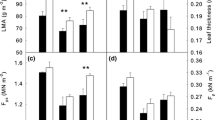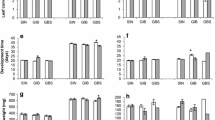Summary
Chemical analysis of each individual leaf of fivePlantago lanceolata (Plantaginaceae) plants showed that iridoid glycoside content increased from undetectable in the oldest photosynthetic leaves to over 9% dry weight in the youngest leaves. The relative proportion of the two iridoid glycosides inP. lanceolata also changed with leaf age: older leaves had significantly more aucubin, whereas the youngest leaves had primarily or solely catalpol. Oviposition tests with femaleJunonia coenia (Nymphalidae) butterflies, showed that they laid most of their eggs on new leaves.
Similar content being viewed by others
References
Baldwin IT, Sims CL, Kean SE (1990) The reproductive consequences associated with inducible alkaloidal responses in wild tobacco. Ecology 71:252–262
Belofsky G, Bowers MD, Jansen S, Stermitz FR (1989) Iridoid glycosides ofAureolaria flava and their sequestration byEuphydryas phaeton butterflies. Phytochemistry 28:1601–1604
Bernays EA, Cornelius ML (1989) Generalist caterpillar prey are more palatable than specialists for the generalist predatorIridomyrmex humilis. Oecologia 79:427–430
Bobbitt JM, Segebarth KP (1969) Iridoid glycosides and similar substances. Pp 1–145in Taylor WI, Battersby AR (eds) Cyclopentanoid Terpene Derivatives. New York: Marcel Dekker
Bowers MD (1984) Iridoid glycosides and host-plant specificity in larvae of the buckeye butterfly,Junonia coenia (Nymphalidae). J Chem Ecol 10:1567–1577
Bowers MD (1991) Iridoid glycosides. Pp 297–325in Rosenthal G, Berenbaum M (eds) Herbivores: Their Interaction with Plant Secondary Metabolites. Vol 1. 2nd ed. Orlando/FL: Academic Press
Bowers MD, Collinge SK (1992) Sequestration and metabolism of iridoid glycosides by larvae of the buckeye,Junonia coenia (Nymphalidae). J Chem Ecol 18:817–831
Bowers MD, Puttick GM (1988) The effect of qualitative variation in iridoid glycosides on generalist and specialist lepidopteran herbivores. J Chem Ecol 14:319–334
Bowers MD, Puttick GM (1989) Iridoid glycosides and insect feeding preferences: gypsy moths,Lymantria dispar (Lymantriidae) and buckeyes,Junonia coenia (Nymphalidae). Ecol Entomol 14:247–256
Bowers MD, Stamp NE (1992) Chemical variation within and between individuals ofPlantago lanceolata (Plantaginaceae). J Chem Ecol 18:985–995
Bowers MD, Stamp NE (1993) Effects of plant age, genotype, and herbivory onPlantago performance and chemistry. Ecology 74:1778–1791
Damtoft S, Jensen SR, Nielsen BJ (1983) The biosynthesis of iridoid glucosides from 8-epi-deoxyloganic acid. Biochem Soc Trans 11:594–595
Duff R, Bacon J, Mundie C, Farmer V, Russell J, Forrester A (1965) Catalpol and methylcatalpol: naturally occurring glycosides inPlantago andBuddleia species. Biochem J 96:1–5
El-Naggar LJ, Beal JL (1980) Iridoids: a review. J Nat Prod 43:649–707
Fajer ED (1989) The effects of enriched CO2 atmospheres on plant-insect herbivore interactions: growth responses of larvae of the specialist butterfly,Junonia coenia (Lepidoptera: Nymphalidae). Oecologia 81:514–520
Gardner DR, Stermitz FR (1988) Hostplant utilization and iridoid glycoside sequestration byEuphydryas anicia (Lepidoptera: Nymphalidae). J Chem Ecol 14:2147–2168
Haukioja E, Neuvonen S (1987) Insect population dynamics and induction of plant resistance: the testing of hypotheses. Pp 411–432in Barbosa P, Schultz JC (eds) Insect Outbreaks. New York: Academic Press
Herms DA, Mattson WJ (1992) The dilemma of plants: to grow or defend. Q Rev Biol 67:283–335
Honda K (1986) Flavanone glycosides as oviposition stimulants in a papilionid butterfly,Papilio protenor. J Chem Ecol 12:1999–2010
Jensen SR, Nielsen BJ, Dahlgren R (1975) Iridoid compounds, their occurrence and systematic importance in the angiosperms. Bot Notiser 128:148–180
Jensen SR (1991) Biosynthesis of iridoid glycosides. Pp 133–158in Harborne JB, Thomas-Barberan FA (eds) Ecological Chemistry and Biochemistry of Plant Terpenoids. GB-Oxford: Oxford University Press
Lincoln DE and JH Langenheim (1978) Effect of light and temperature on monoterpenoid yield and composition inSatureja douglasii. Biochem Syst Ecol 6:21–32
Lincoln DE, Langenheim JH (1981) A genetic approach to monoterpenoid compositional variation inSatureja douglasii. Biochem Syst Ecol 9:153–160
Marquis RJ (1984) Leaf herbivores decrease fitness of a tropical plant. Science 226:537–539
Marquis RJ (1990) Genetic variation in leaf damage inPiper arieianum (Piperaceae) by a multispecies assemblage of herbivores. Evolution 44:104–120
McKey D (1979) The distribution of secondary compounds within plants. Pp 59–133in Rosenthal G, Janzen DH (eds) Herbivores: Their Interactions with Secondary Plant Metabolites. New York: Academic Press
Nelson CJ, Seiber JN, Brower LP (1981) Seasonal and intraplant variation of cardenolide content in the California milkweed,Asclepias eriocarpa, and implications for plant defense. J Chem Ecol 7:981–1010
Ohsugi T, Nishida R, Fukami H (1985) Oviposition stimulant ofPapilio xuthus, aCitrus feeding swallowtail butterfly. Agric Biol Chem 49:1897–1900
Oyeyele SP, Zalucki MP (1990) Cardiac glycosides and oviposition byDanaus plexippus onAsclepias fruticosa in south-east Queensland (Australia), with notes on the effect of plant nitrogen content. Ecol Entomol 15:177–185
Papaj DR, Rausher MD (1983) Individual variation in host location by phytophagous insects. Pp 77–124in Ahmad A (ed.) Herbivorous Insects: Hostseeking Behavior and Mechanisms. New York: Academic Press
Pereyra PC, Bowers MD (1988) Iridoid glycosides as oviposition stimulants for the buckeye,Junonia coenia (Nymphalidae). J Chem Ecol 14:917–928
Raupp MJ, Denno RF (1983) Leaf age as a predictor of herbivore distribution and abundance. Pp 91–124in Denno RF, McClure MD (eds) Variable Plants and Herbivores in Natural and Managed Systems. New York: Academic Press
Schoonhoven L (1972) Secondary plant substances and insects. Recent Adv Phytochem 5:197–224
Scott JA (1986) The Butterflies of North America. Stanford/CA: Stanford University Press
Simms EL, Rausher MD (1987) Costs and benefits of plant resistance to herbivory. Amer Natur 130:570–581
Stamp NE (1982) Selection of oviposition sites by the Baltimore checkerspotEuphydryas phaeton (Nymphalidae). J Lepid Soc 36:290–302
Wu L, Antonovics J (1975) Experimental ecological genetics inPlantago. I. Induction of roots and shoots on leaves for large scale vegetative propagation and metal tolerance testing inP. lanceolata. New Phytol 75:277–282
Zucker WV (1982) How aphids choose leaves; the roles of phenolics in host selection by a galling aphid. Ecology 63:972–981
Zalucki MP, Brower LP, Malcolm SB (1990) Oviposition byDanaus plexippus in relation to cardenolide content of threeAsclepias species in the southeastern U.S.A. Ecol Entomol 15:231–240
Author information
Authors and Affiliations
Rights and permissions
About this article
Cite this article
Klockars, G.K., Bowers, M.D. & Cooney, B. Leaf variation in iridoid glycoside content ofPlantago lanceolata (Plantaginaceae) and oviposition of the buckeye,Junonia coenia (Nymphalidae). Chemoecology 4, 72–78 (1993). https://doi.org/10.1007/BF01241676
Issue Date:
DOI: https://doi.org/10.1007/BF01241676




